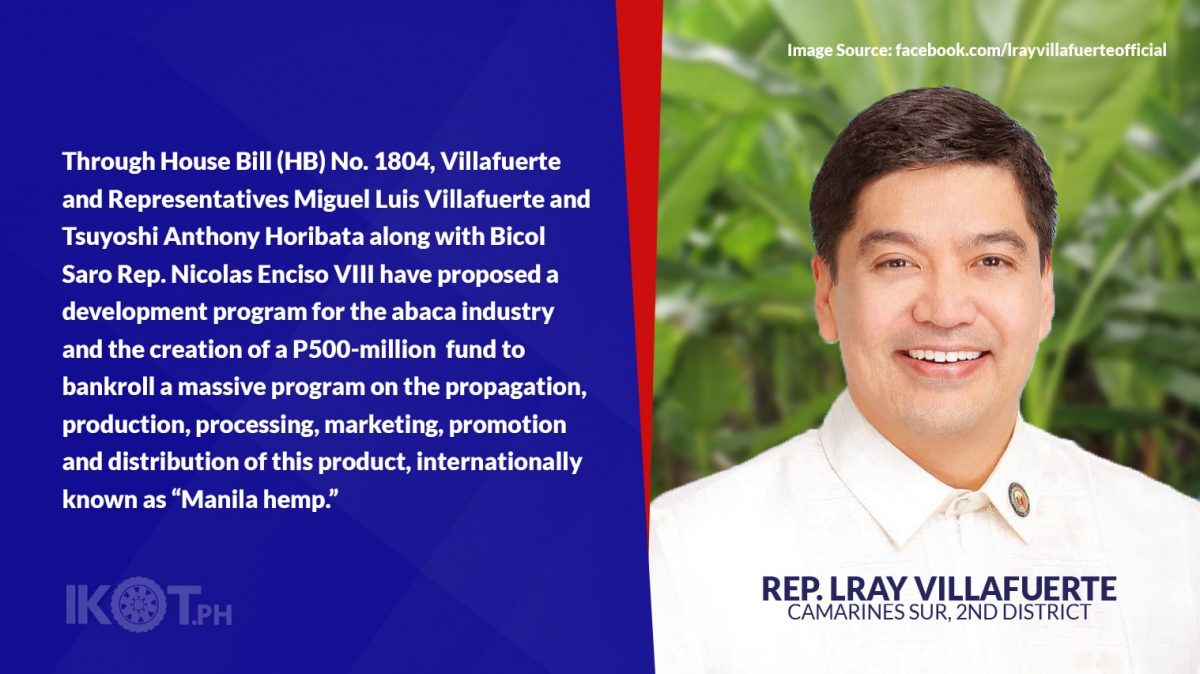Camarines Sur Rep. LRay Villafuerte and three more of his fellow lawmakers from the Bicol region have asked Congress to institutionalize the Philippine Abaca Industry Development Program as a companion measure to the recently enacted law declaring Catanduanes as the country’s abaca capital.
Through House Bill (HB) No. 1804, Villafuerte and Representatives Miguel Luis Villafuerte and Tsuyoshi Anthony Horibata along with Bicol Saro Rep. Nicolas Enciso VIII have proposed a development program for the abaca industry and the creation of a P500-million fund to bankroll a massive program on the propagation, production, processing, marketing, promotion and distribution of this product, internationally known as “Manila hemp.”
“Reportedly, demand for the commodity is increasing while production has slowed. In addressing this, the bill proposes for the production extension and infrastructure development for the industry to provide adequate technologies and facilities for production and strengthen the sectors involved in the development of the Philippine Abaca.”
The four HB 1804 authors said that while they recognize the potential of the abaca industry and the government’s declaration of Catanduanes as the Philippines’ abaca capital, more needs to be done to upskill the abaca sector and boost its production, especially now amid reports of declining output.
“Reportedly, demand for the commodity is increasing while production has slowed. In addressing this, the bill proposes for the production extension and infrastructure development for the industry to provide adequate technologies and facilities for production and strengthen the sectors involved in the development of the Philippine Abaca,” they said.
Under the bill, these Bicolano legislators have proposed the creation of a Philippine Abaca Development Fund (PADF), with an initial amount of P 500 million to be added by the Department of Budget and Management (DBM) to the allocation for the Philippine Fiber Industry Development Authority (PhilFIDA).
Rep. LRay Villafuerte, who is vice president for political affairs of the National Unity Party (NUP), had introduced a similar proposal—HB 1265—in the previous Congress.
He and his three co-authors noted in HB 1804 that Republic Act (RA) No. 11707, which was signed by then-President Duterte to declare Catanduanes as the “Abaca Capital” of the country, was principally authored by Sen. Cynthia Villafuerte.
Although this law recognized the importance of this industry as a driver of rural development, he said RA 11797 is actually silent on the establishment of a fund to scale up state support for abaca development.
HB 1804’s authors said their proposal in the bill to set up initial and annual funding of P500 million for up to 10 years is in addition to PhilFIDA’s allocation under the national budget for the development of other fibers and its administrative, regulatory, and operational expenses.
Of this amount, P50 million shall be allocated for the Philippine Abaca Research Center at the Visayas State University in Baybay, Leyte, for the abaca research and development (R&D) and extension program, the bill states.
Abaca output fell 13.7% to 8,693.38 metric tons (MT) in the first two months of 2022, according to PhilFIDA.
“The future is filled with opportunities for the Abaca industry, with new hybrid varieties being produced and studied by experts in the country. And with demand not showing signs of slowing down, focus on the sustainability of the Abaca plant and the industry, in general, is imperative,” they said.
Philippine abaca has evolved into a number of uses, such as a substitute for synthetic materials like plastic. Its high tensile strength and versatility for manufacturing a wide range of products have propelled the Philippines to be the largest producer of abaca fibers, supplying about 87 percent of the world’s requirement for the produce, they added.
The abaca industry has recorded an annual average of P4.7 billion in export earnings, based on data from PhilFIDA.
Under the bill, the proposed Philippine Abaca Industry Development Program will run for 10 years and will consist of the framework for plans, projects, and policies for the scientific propagation, processing utilization, and expansion of trade of Philippine Abaca.
“This aims to also help solve problems in the cultivation of Abaca plants and ensure its competitiveness,” they said.
Abaca output fell 13.7% to 8,693.38 metric tons (MT) in the first two months of 2022, according to PhilFIDA.
Top producer Bicol region’s output fell 34.9 to 2,361.37 MT. Central Visayas production was down 24.4% at 27.68 MT, Davao region down 21.8% at 1,705.14, Autonomous Region in Muslim Mindanao (ARMM) down 16.2% at 451.27, Northern Mindanao down 13.2% at 1,137.5 MT, Zamboanga Peninsula down 8% at 82.69 MT, and Central Luzon down 5.1% at 6.15 MT.
The South Cotabato-Cotabato-Sultan Kudarat-Saranggani-General Santos City (SOCCSKSARGEN) region reported the biggest decline of 55.7% to 185.83 MT.
PhilFIDA said the abaca industry can still find time to recover and meet the agency’s output target of 70,000 MT for this year.


